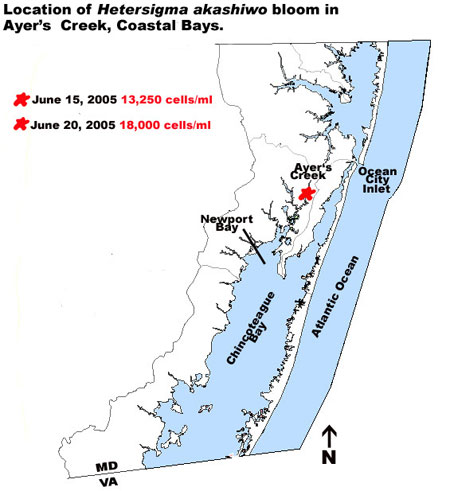|
|
A potentially ichthyotoxic (i.e., toxic to fish) algal species, Heterosigma akashiwo, was identified by Maryland Department of Natural Resources during routine water quality monitoring on June 15 in Ayer's Creek, Coastal Bays, at bloom densities of 13,250 cells per milliliter. On June 20, a second sample was collected at the same location and contained 18,000 H. akashiwo cells per milliliter. No fish kills were associated with this Coastal Bays bloom location at this time. A toxicity bioassay was conducted by the laboratory of Dr. Carm Tomas, University of North Carolina Wilmington, Center for Marine Science, on a sample of the bloom water. Results were negative for toxic activity. Dr. Tomas indicated Delawares Inland Bays have produced blooms of this species up to 70,000 cells per milliliter this year with no observed living resource effects. Blooms of this species persist as long as stable water stratification is present in warmer months. Worldwide, the likelihood of encountering H. akashiwo blooms has been most related to water temperature (>59 degrees F) and moderate salinity (approximately 15 ppt). Maryland DNR’s continuous water quality monitoring station at Public Landing on the Coastal Bays shows water temperatures are generally above 70 degrees F now in the region. For additional water quality information on the Coastal Bays, please check DNR’s Coastal Bays website and link to continuous monitoring station data. Additionally, access DNR's long term monthly monitoring station data and other continuous monitoring site information at DNR’s Eyes on the Bay website. Heterosigma akashiwo is best known for its relationship with fish kills around the world. This species is considered the causative organism involved in fish farm kills in Washington State and Japan. Fish kills have occurred in regions of the world with abundances of H. akashiwo containing at least 1,000 cells per milliliter. There are no documented effects to humans from such H. akashiwo blooms. No fish or human health effects have been associated with blooms of this species in Maryland waters to date. However, low level toxic activity has been identified from Heterosigma bloom samples on the Coastal Bays by Dr. Carm Tomas in the past and therefore particular attention is given to tracking blooms of species. Maryland DNR will continue to monitor this bloom. For up to date information on all of Maryland's harmful algal blooms and water quality monitoring results, please visit Eyes on the Bay |

